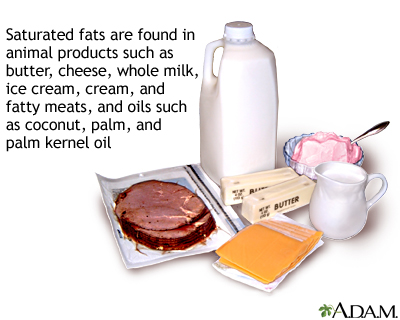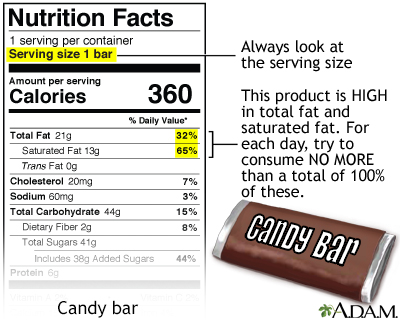Diet-busting foods
Obesity - diet-busting foods; Overweight - diet-busting foods; Weight loss - diet busting foods
Diet-busting foods work against you if you are watching your weight. These foods may taste good, but are low in nutrition and high in calories. Many of these foods leave you feeling hungry because they are low in fiber or protein. In general, diet-busting foods should make up a very small portion of your overall diet.

Saturated fats are found predominantly in animal products such as meat and dairy products, and can be associated with higher cholesterol levels. Tropical oils such as palm, coconut, and coconut butter, are also high in saturated fats.

Saturated fats are found in animal products such as butter, cheese, whole milk, ice cream, cream, and fatty meats. They are also found in some vegetable oils -- coconut, palm, and palm kernel oils. Eating too much saturated fat is one of the major risk factors for heart disease. A diet high in saturated fat causes a soft, waxy substance called cholesterol to build up in the arteries. Too much fat also increases the risk of heart disease because of its high calorie content, which increases the chance of becoming obese (another risk factor for heart disease and some types of cancer).
Worst Offenders
High-fat foods. Most high-fat foods have a lot of calories but little nutrition. Many of these diet-busting foods are made with unhealthy saturated or trans fats. These types of fats are solid at room temperature. For instance, the fat in cheese and butter is solid. By contrast, heart-healthy olive oil is a liquid fat. Still, you should always control your portions, because too much of any fat can lead to weight gain.
High-fat foods include:
- Fatty meats, such as sausage, bacon, and ribs
- Dishes made with full-fat cheese, such as pizza, burritos, and mac and cheese
- Fried foods
- Whole-fat dairy foods, such as ice cream or pudding
- Foods prepared in cream, such as creamy sauces and soups
Refined grains. Unlike diet-boosting whole grains, most of the nutrients and fiber have been stripped away from these grains in the refining process. As a result, they leave you hungry.
Refined grains include:
- White bread
- Pasta made with white flour
- White rice
High-calorie drinks. Sweetened beverages are generally very high in calories.
- Soda. A 16-ounce (oz) or 480 milliliter (mL) can of sugary soda has almost as many calories as a cookie.
- Fruit juice. Many fruit juices sold in stores are high in sugar and low in fruit. Look for 100% fruit juice with no added corn syrup, dextrose, sucrose, or syrup. Watch your serving size, because 100% juices are still high in calories. They often do not have as many nutrients as the whole fruit they are squeezed from. A better option is to eat a piece of fruit. The added fiber and bulk will help you feel fuller.
- Sports and energy drinks. Many of these drinks are high in sugar and calories. Energy drinks also have a lot of caffeine. Unless you exercise hard enough to sweat for an hour or more, you are better off drinking water. You can also choose low-calorie versions of these drinks.
- Coffee drinks. Coffee is low in calories on its own. But once you add high-fat milk, sugary flavorings, and whipped cream, the calorie count soars.
Baked goods. High in fat, sugar, and refined grains, pastries and baked desserts are diet-busters on every level. Limit these foods to the occasional treat and make sure you watch your portion sizes. These include:
- Donuts
- Muffins
- Scones
- Cake
- Cookies
- Brownies
Some of These Foods may Seem Healthy, But They are not
Exercise bars. These bars may have earned their healthy reputation because they are sold to give you energy for exercise. But most of them are more like candy bars: low in fiber, and high in sugar, fat, and calories. Choose bars high in fiber and lower in sugar and fat when you need an energy boost. Unless you need some quick energy in the middle of a race or training session, look for a healthier way to refuel.
Cream-based soups. The advice to make a meal of soup and salad can backfire if your cup of soup has the calorie and fat profile of a hamburger. Creamy soups like mushroom bisque and many chowders have around 400 calories in 1 cup (c) or 0.24 liters (L). Broth-based soups like minestrone have around 100 calories.
Creamy salad dressing. Ranch, peppercorn, and blue cheese dressings can turn a healthy salad into a high-fat meal. But you do not need to go totally nonfat. Instead, use a spoonful of dressing made with healthy fats such as avocados, olive oil, or yogurt. If you do choose to indulge in a creamy dressing, measure it out carefully and limit your portions to no more than 1 to 2 tablespoons (tbsp) or 15 to 30 mL.
Sugar-free foods. If a food that is usually made with sugar is labeled sugar free, check the calories on the nutrition label. Often, extra fat and salt are added to make up for the lack of sugar.
Potatoes. Whether a potato is diet-busting or diet-boosting depends on how you cook it. A baked potato has about 120 calories. You can top it with broccoli and drizzle it with olive oil. But once you fry a potato or turn it into hash browns, the calories more than double and unhealthy fats increase dramatically.
Healthy in Small Amounts
Nuts. High in fiber, nuts are a tasty way to eat heart-healthy fat. But nuts are also high in calories. One cup of chopped nuts can contain more than 700 calories. To get a dose of protein and heart-healthy fat, limit yourself to 1 to 2 tbsp (15 to 30 mL) of peanut butter or a small handful of unsalted nuts like almonds or walnuts.
Dried fruit. The drying process takes away the water and a lot of the volume, making dried fruit higher in calories and sugar than a similar portion size of fresh fruit. A cup or 160 grams (g) of dried figs has 371 calories and 71 g of sugar. Compare that to 2 large fresh figs, which have a total of 94 calories and 20 g of sugar. Portion control is the key to eating dried fruit without busting your diet.
Granola. This is another food best eaten in small portions. A cup (112 g) of granola can range from 343 calories in a low-fat version you buy in the store, to 597 calories in a cup of homemade granola. Many commercial versions have added sugar and fat. Like dried fruit and nuts, granola is packed with fiber and nutrients. Read labels, pay attention to serving sizes, watch the calorie count, and eat granola in small amounts. A half cup (60 g) or less can dress up a bowl of nonfat yogurt or make a delicious topping for fresh fruit.
References
Academy of Nutrition and Dietetics website. Food.
Academy of Nutrition and Dietetics website. Use the dietary guidelines, myplate and food labels to make healthy choices
Mozaffarian D. Nutrition and cardiovascular and metabolic diseases. In: Libby P, Bonow RO, Mann DL, Tomaselli GF, Bhatt DL, Solomon SD, eds. Braunwald's Heart Disease: A Textbook of Cardiovascular Medicine.12th ed. Philadelphia, PA: Elsevier; 2022:chap 29.
Snetselaar LG, de Jesus JM, DeSilva DM, Stoody EE. Dietary guidelines for Americans, 2020-2025: understanding the scientific process, guidelines, and key recommendations. Nutr Today. 2021;56(6):287-295. PMID: 34987271
Version Info
Last reviewed on: 9/4/2024
Reviewed by: Jacob Berman, MD, MPH, Clinical Assistant Professor of Medicine, Division of General Internal Medicine, University of Washington School of Medicine, Seattle, WA. Also reviewed by David C. Dugdale, MD, Medical Director, Brenda Conaway, Editorial Director, and the A.D.A.M. Editorial team.
